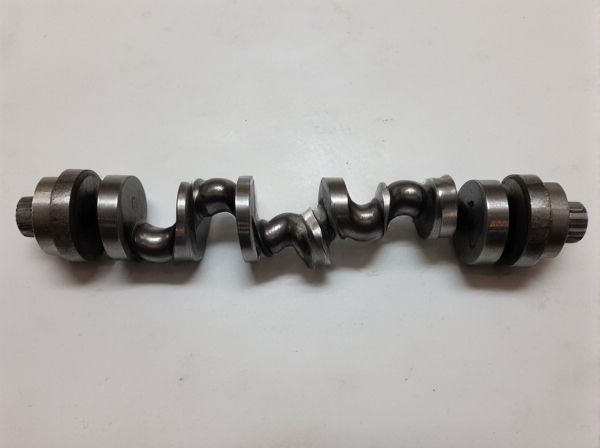
Photo illustration: Fully Machined vs Semi-finished Crankshaft
Fully machined crankshafts offer precise dimensions and smooth surfaces, reducing wear and enhancing engine performance right out of production. Semi-finished crankshafts require additional machining processes to meet exact specifications, providing flexibility for custom modifications or specific engine requirements. Your choice impacts manufacturing time, cost, and the level of precision achieved in the final engine assembly.
Table of Comparison
| Feature | Fully Machined Crankshaft | Semi-finished Crankshaft |
|---|---|---|
| Definition | Crankshaft ready for immediate installation after manufacturing. | Partially machined crankshaft requiring further processing. |
| Manufacturing Process | Complete machining including journals, bearing surfaces, and balancing. | Basic machining with rough surfaces; finishing required. |
| Surface Finish Quality | High precision, smooth finish for optimal engine performance. | Coarse finish; additional polishing needed. |
| Cost | Higher initial cost due to complete machining. | Lower upfront cost, but higher finishing expenses. |
| Lead Time | Shorter lead time; ready for use immediately. | Longer lead time due to extra machining steps. |
| Application | Suitable for direct engine assembly and high-performance engines. | Used when customized finishing or balancing is required. |
| Dimensional Accuracy | High tolerance control meeting OEM standards. | Lower tolerance; needs precision finishing. |
| Balancing | Pre-balanced to minimize vibrations. | Unbalanced; requires balancing before use. |
Introduction to Fully Machined and Semi-finished Crankshafts
Fully machined crankshafts undergo complete precision machining, ensuring optimal surface finish, dimensional accuracy, and balanced performance crucial for high-stress engine operations. Semi-finished crankshafts, produced through forging or casting, require further machining to reach final specifications, offering a cost-effective solution for less demanding applications. Choosing between fully machined and semi-finished crankshafts depends on engine performance requirements, manufacturing costs, and material properties.
Definition and Manufacturing Processes
Fully machined crankshafts undergo complete precision machining, including grinding, polishing, and balancing, to meet exact specifications and ensure optimal performance and durability. Semi-finished crankshafts are partially machined, typically requiring further processing such as final grinding and balancing before use, often produced through forging or casting followed by rough machining. Manufacturing processes for fully machined crankshafts involve advanced CNC machining centers and quality control measures, while semi-finished crankshafts focus on initial shaping and rough cuts to reduce material waste and machining time.
Key Differences: Fully Machined vs Semi-finished
Fully machined crankshafts undergo precision grinding, balancing, and finishing processes, resulting in higher dimensional accuracy and surface smoothness compared to semi-finished crankshafts. Semi-finished crankshafts typically require additional machining to meet final specifications, as they are partially processed with rougher surfaces and less accurate dimensions. The key differences lie in production readiness, with fully machined crankshafts being ready for immediate installation, while semi-finished versions demand further machining for optimal engine performance.
Material Selection and Compatibility
Fully machined crankshafts are crafted from high-quality forged steel or billet materials, ensuring superior strength and fatigue resistance suitable for high-performance engines. Semi-finished crankshafts often use cast iron or lower-grade steel alloys, requiring additional machining to achieve precise tolerances, which can affect compatibility with performance upgrades. Material selection directly influences compatibility with engine components and thermal stability, with fully machined crankshafts offering enhanced durability and reliability under demanding conditions.
Performance and Durability Comparison
Fully machined crankshafts undergo precise CNC processing to achieve superior dimensional accuracy and surface finish, resulting in enhanced engine performance through reduced vibrations and better balance. Semi-finished crankshafts require additional grinding and finishing, which can introduce minor variances impacting overall durability and long-term reliability. The improved consistency and tighter tolerances of fully machined crankshafts contribute to greater strength, fatigue resistance, and extended service life compared to semi-finished counterparts.
Cost Implications and Budget Considerations
Fully machined crankshafts generally incur higher initial costs due to precision machining and quality control, making them suitable for high-performance and long-lasting engine applications. Semi-finished crankshafts offer a budget-friendly alternative, requiring additional machining at the time of assembly, which can save upfront expenses but may increase long-term labor and tooling costs. Budget considerations should balance the upfront machining investment against potential maintenance, performance requirements, and overall lifecycle expenses for optimal cost efficiency.
Application Suitability in Automotive and Industrial Sectors
Fully machined crankshafts offer precise dimensional accuracy and superior surface finish, making them ideal for high-performance automotive engines requiring maximum reliability and efficiency. Semi-finished crankshafts are typically preferred in industrial applications where cost-effectiveness and customization for heavy-duty equipment outweigh the need for extreme precision. Automotive sectors benefit from fully machined options for enhanced engine speed and durability, while industrial sectors often opt for semi-finished crankshafts due to their adaptability and lower production costs.
Maintenance and Service Life Expectations
Fully machined crankshafts offer enhanced dimensional accuracy and surface finish, resulting in improved wear resistance and lower maintenance frequency compared to semi-finished crankshafts. Semi-finished crankshafts require additional machining and finishing steps, increasing the risk of dimensional inconsistencies that can lead to premature wear and higher maintenance costs. Proper maintenance of fully machined crankshafts typically extends service life by reducing stress concentrations and preventing early failure in high-performance engine applications.
Quality Control and Precision Standards
Fully machined crankshafts undergo rigorous quality control processes, including CNC machining and precision balancing, ensuring dimensional accuracy within micrometer tolerances. Semi-finished crankshafts require additional finishing operations, which can introduce variability in tolerances and surface integrity, potentially affecting overall performance. Precision standards for fully machined crankshafts meet stringent requirements for engine efficiency, vibration reduction, and durability, making them preferable for high-performance applications.
Choosing the Right Crankshaft for Your Needs
Choosing between a fully machined and a semi-finished crankshaft depends on application requirements such as performance, budget, and production timeline. Fully machined crankshafts offer precision and immediate usability with optimal surface finishes and dimensional accuracy, ideal for high-performance engines and OEM replacements. Semi-finished crankshafts require additional machining processes, providing cost savings and customization flexibility for rebuilds or modified engines but demand skilled labor and equipment for proper finishing.
 caratoz.com
caratoz.com